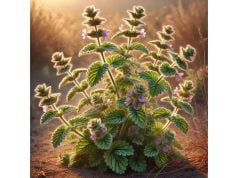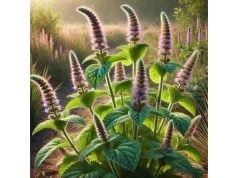Himalayan Fir is a majestic conifer native to the rugged, high-altitude regions of the Himalayas. Renowned for its aromatic resin and potent essential oils, this evergreen tree has long been revered in traditional medicine for its diverse healing properties. From respiratory support and stress relief to its antioxidant and anti-inflammatory effects, Himalayan Fir is valued by herbal practitioners and modern researchers alike. This comprehensive guide explores the botanical profile, chemical makeup, health benefits, practical applications, and scientific studies related to Himalayan Fir—providing an in-depth resource for herbal enthusiasts, practitioners, and researchers interested in harnessing nature’s potent remedies.
Table of Contents
- Botanical Profile and Identification of Himalayan Fir
- Phytochemical Composition and Active Constituents
- Therapeutic Benefits and Core Therapeutic Properties
- Practical Applications and Usage Guidelines
- Scientific Research and Key Study Insights
- Frequently Asked Questions
Botanical Profile and Identification of Himalayan Fir
Himalayan Fir (Abies spectabilis and related species) is an emblematic conifer of the Himalayan region, thriving in the cold, mountainous climates where only the hardiest flora can survive. This evergreen tree is characterized by its tall, slender form, conical crown, and distinctive needle-like leaves that emit a refreshing, resinous aroma when crushed. The bark, typically smooth and grayish when young, develops deep fissures with age, contributing to the tree’s rugged aesthetic. Its cones, elongated and cylindrical, hang gracefully from the branches and serve as a key reproductive structure, releasing winged seeds that are dispersed by the wind.
Taxonomy and Morphological Features
Botanically, Himalayan Fir belongs to the Pinaceae family, sharing close kinship with other fir species found across temperate regions. Its taxonomic classification reflects its adaptation to high-altitude ecosystems and resilience under harsh environmental conditions. The needles, typically arranged in a spiral on the branches, are flat, soft, and dark green with a silvery underside—an adaptation that minimizes water loss while maximizing photosynthesis in thin mountain air. The cones, which mature over a period of one to two years, are uniquely structured to withstand strong Himalayan winds, ensuring the efficient dispersal of seeds across rugged terrains.
Growth Conditions and Natural Habitat
Himalayan Fir is predominantly found at elevations ranging from 2,000 to 3,500 meters, where the climate is marked by cool temperatures, heavy snowfall in winter, and brisk, gusty winds. The species thrives in well-drained, loamy soils enriched with organic matter derived from decaying vegetation. Its deep-rooted system not only secures it against high winds and soil erosion but also allows it to tap into water sources in an environment where precipitation can be sporadic. This remarkable adaptation enables Himalayan Fir to maintain its vitality even under conditions of limited water availability and significant diurnal temperature variations.
Ecological and Cultural Importance
In its native habitat, Himalayan Fir plays a pivotal role in maintaining ecological balance. The tree acts as a natural windbreak, preventing soil erosion and stabilizing steep mountain slopes. Its dense canopy offers shelter to a myriad of wildlife species, while its resin and fallen needles contribute to the nutrient cycle within the forest ecosystem. Culturally, Himalayan Fir holds deep significance for local communities. Traditional healers have long harnessed its resin, bark, and essential oils to treat respiratory ailments, skin conditions, and inflammatory disorders. The tree is also featured in local folklore and religious practices, symbolizing strength, longevity, and purity.
Conservation and Sustainable Management
Despite its ecological and cultural value, Himalayan Fir faces mounting threats from overharvesting, deforestation, and the impacts of climate change. Unsustainable logging practices, driven by the high demand for its resin and timber, have led to a gradual decline in natural populations. Conservation initiatives now focus on sustainable harvesting techniques and reforestation programs to ensure that this vital species continues to thrive. Researchers and environmentalists are working together to develop management practices that balance the economic benefits of Himalayan Fir with the need to preserve its natural habitat for future generations.
In summary, the botanical profile and identification of Himalayan Fir underscore its adaptability, ecological significance, and cultural importance. This resilient conifer not only embodies the natural beauty of the Himalayan landscape but also serves as a cornerstone of traditional medicine and modern ecological conservation. The following sections will delve into the intricate chemical composition of this remarkable tree and explore the myriad health benefits and practical applications derived from its bioactive compounds.
Phytochemical Composition and Active Constituents
The therapeutic prowess of Himalayan Fir is largely attributed to its rich and complex phytochemical composition. Modern analytical techniques have revealed an array of bioactive compounds present in various parts of the tree—including its needles, bark, and resin—that collectively contribute to its potent medicinal properties. Below is an exploration of the key constituents and their roles:
- Monoterpenes (Alpha-Pinene, Beta-Pinene, Limonene)
Monoterpenes are among the most abundant volatile compounds found in Himalayan Fir. These essential oil components, responsible for the tree’s characteristic pine-like aroma, have demonstrated significant anti-inflammatory and antimicrobial properties. Alpha-pinene and beta-pinene, in particular, are known to promote respiratory health by easing congestion and supporting natural immune responses. Additionally, limonene contributes to the uplifting and mood-enhancing effects often associated with fir-based aromatherapy. - Sesquiterpenes
Sesquiterpenes, which include compounds such as caryophyllene, are found in the resin and contribute to the tree’s distinctive scent and flavor. These compounds have been shown to exhibit anti-inflammatory and analgesic effects, making them valuable in the management of chronic pain and inflammatory conditions. Their complex chemical structure also allows them to interact synergistically with other phytochemicals, enhancing the overall therapeutic profile of Himalayan Fir. - Flavonoids
The needles and bark of Himalayan Fir are rich in flavonoids—a diverse group of polyphenolic compounds known for their powerful antioxidant properties. Flavonoids such as quercetin and kaempferol help neutralize free radicals, protect cellular structures from oxidative damage, and support cardiovascular health. Their anti-inflammatory effects further contribute to the herb’s potential in mitigating chronic inflammatory disorders. - Phenolic Acids
Phenolic acids, including caffeic and ferulic acids, are secondary metabolites present in the tree that bolster its antioxidant defenses. These compounds are effective in reducing oxidative stress, thus contributing to the overall anti-aging and protective benefits of Himalayan Fir. In traditional medicine, phenolic acids are often credited with supporting skin regeneration and maintaining healthy tissue function. - Resin Acids and Diterpenes
Resin acids, such as abietic acid, along with various diterpenes, are major components of the sticky resin exuded by Himalayan Fir. These substances are known for their antimicrobial and anti-inflammatory activities, and they play a crucial role in the tree’s natural defense mechanisms. The resin has been used traditionally to treat minor wounds and skin infections, harnessing its ability to create a protective barrier against pathogens. - Tannins
Tannins are astringent compounds found in the bark that contribute to its protective properties. They help tighten tissues and reduce inflammation, making them effective in managing skin irritations and minor abrasions. Tannins also exhibit mild antimicrobial effects, further supporting their role in wound healing and topical applications.
The interplay among these phytochemicals creates a synergistic effect that amplifies the health benefits of Himalayan Fir. Whether used in aromatherapy, topical formulations, or ingestible preparations, the active constituents work together to provide a broad spectrum of therapeutic actions. Ongoing research continues to uncover additional minor compounds that may further enhance the medicinal value of this Himalayan treasure. By understanding the chemical composition of Himalayan Fir, both traditional healers and modern scientists can harness its full potential in promoting health and well-being.
Therapeutic Benefits and Core Therapeutic Properties
The extensive range of health benefits attributed to Himalayan Fir is a direct result of its rich phytochemical profile. Traditional medicine systems have long used this coniferous tree to treat a variety of ailments, and modern research is gradually confirming these age-old practices. Here, we explore the core therapeutic properties that make Himalayan Fir a valuable natural remedy.
Respiratory Health and Immune Support
One of the most celebrated benefits of Himalayan Fir is its positive impact on respiratory function. The essential oils extracted from its needles, rich in monoterpenes like alpha-pinene and beta-pinene, are known to ease congestion, clear airways, and support natural immune responses. Inhalation of these volatile compounds through aromatherapy or steam inhalation can provide relief from colds, coughs, and bronchial irritations. The antimicrobial properties of these oils also help fend off respiratory infections, making Himalayan Fir a trusted ally during seasonal outbreaks.
Anti-Inflammatory and Antioxidant Effects
Himalayan Fir’s potent anti-inflammatory and antioxidant activities are among its most significant therapeutic attributes. The combined action of flavonoids, phenolic acids, and resin acids works to neutralize free radicals and reduce inflammation at the cellular level. This dual action not only helps protect against chronic diseases such as arthritis, cardiovascular disorders, and neurodegenerative conditions but also supports overall cellular health. Regular use of fir-based remedies may aid in the prevention of oxidative stress-related damage, contributing to a healthier, more resilient body.
Skin Regeneration and Wound Healing
Traditional applications of Himalayan Fir extend to the realm of dermatology. The tannins and resin acids found in its bark are known for their astringent and antimicrobial properties, making them effective in treating minor cuts, abrasions, and skin irritations. Topical formulations, such as creams and salves infused with fir extract, can accelerate wound healing, reduce inflammation, and promote skin regeneration. Furthermore, the antioxidant properties of the flavonoids help protect the skin from environmental damage and premature aging.
Stress Relief and Mental Clarity
The invigorating aroma of Himalayan Fir, derived from its essential oils, has been associated with mood enhancement and stress reduction. Aromatherapy sessions using fir oil have been reported to promote relaxation, alleviate anxiety, and improve mental clarity. These mood-boosting effects are likely mediated by the stimulation of the limbic system, which plays a key role in emotional regulation. As a natural adaptogen, Himalayan Fir may help the body cope with the stressors of modern life, fostering a sense of calm and balance.
Cardiovascular and Metabolic Support
Emerging research indicates that the antioxidant and anti-inflammatory compounds in Himalayan Fir can also benefit cardiovascular health. By supporting the integrity of blood vessels, reducing oxidative stress, and promoting healthy blood flow, fir extracts may help regulate blood pressure and improve overall vascular function. Additionally, the metabolic benefits of fir—stemming from its ability to enhance digestion and nutrient absorption—can contribute to improved energy levels and a balanced metabolism, further supporting heart health.
Holistic Well-Being and Adaptogenic Qualities
Beyond its specific therapeutic actions, Himalayan Fir embodies a holistic approach to health. Its complex blend of bioactive compounds addresses multiple physiological systems simultaneously, offering a comprehensive natural remedy that promotes overall well-being. Whether used as a dietary supplement, inhaled as an essential oil, or applied topically, Himalayan Fir offers integrative support for both physical and mental health, reinforcing its status as a versatile and enduring natural remedy.
In summary, the therapeutic benefits and core properties of Himalayan Fir are extensive and multifaceted. Its ability to support respiratory function, reduce inflammation, promote skin health, enhance mental clarity, and support cardiovascular wellness makes it an invaluable component in both traditional herbal medicine and modern natural health practices. The next section details practical applications and guidelines for safely incorporating Himalayan Fir into your wellness regimen.
Practical Applications and Usage Guidelines
Himalayan Fir offers a wealth of applications across various domains, from medicinal and cosmetic uses to aromatherapy and even culinary innovations in some traditional practices. Here, we outline practical methods for incorporating Himalayan Fir into your daily routine, along with essential safety precautions and dosage recommendations.
Medicinal Preparations and Traditional Remedies
Traditional healers have long used different parts of the Himalayan Fir—needles, bark, and resin—to create potent herbal remedies. Some common preparations include:
- Decoctions and Infusions:
Boiling the needles or bark in water extracts the active compounds, creating a warming and aromatic decoction. This remedy is traditionally consumed to relieve respiratory congestion, soothe sore throats, and alleviate symptoms of colds and flu. Simmer 5–10 grams of dried material per cup of water for 15–20 minutes for optimal extraction. - Tinctures and Extracts:
Alcohol-based tinctures offer a concentrated form of Himalayan Fir’s bioactives. A few drops diluted in water or tea can provide quick relief for inflammation and respiratory discomfort. Standard dosages range from 250 to 500 mg per day, though consulting with an herbalist for personalized advice is recommended. - Topical Applications:
Creams, ointments, and salves formulated with Himalayan Fir extract are widely used for their antimicrobial and anti-inflammatory properties. These products can aid in wound healing, reduce skin irritation, and promote overall skin regeneration. A patch test is advised before extensive application to ensure there is no sensitivity.
Aromatherapy and Essential Oil Uses
The essential oil of Himalayan Fir, extracted from its needles, is highly prized for its invigorating aroma and therapeutic properties:
- Diffusers and Inhalation:
Adding a few drops of fir essential oil to a diffuser can create a calming, forest-like atmosphere. Inhaling the vapors is particularly effective for relieving respiratory congestion, enhancing mood, and reducing stress. For steam inhalation, add 3–5 drops to a bowl of hot water, cover your head with a towel, and breathe deeply for 5–10 minutes. - Massage Oils and Bath Blends:
Diluting Himalayan Fir essential oil in a carrier oil (such as jojoba or almond oil) makes it suitable for massage therapy. This not only helps soothe muscle tension but also improves circulation. Additionally, adding a few drops to a warm bath can provide a relaxing, detoxifying experience.
Culinary and Nutritional Incorporation
While Himalayan Fir is primarily known for its medicinal and aromatic properties, certain traditional practices have incorporated its young needles and resin in culinary applications. In some regions, the needles are used as a flavoring agent in teas or broths, imparting a subtle, refreshing taste. When used in food preparations, it is essential to ensure that the material is sourced from non-contaminated environments and prepared following traditional guidelines to preserve its nutritional benefits.
Dosage Guidelines and Safety Recommendations
To safely harness the benefits of Himalayan Fir, consider the following best practices:
- Start with Low Doses:
Whether using tinctures, decoctions, or essential oils, begin with a small dose to assess tolerance. Gradually increase the dose under the guidance of a healthcare professional. - Quality Assurance:
Source products from reputable suppliers to ensure purity and proper processing. Contaminants or adulterants can compromise the safety and efficacy of herbal preparations. - Monitor for Allergic Reactions:
Although Himalayan Fir is generally well tolerated, some individuals may experience mild skin irritation or respiratory discomfort. Discontinue use if any adverse reactions occur and consult a healthcare provider. - Consult Healthcare Professionals:
If you are pregnant, breastfeeding, or taking other medications (especially anticoagulants or respiratory drugs), seek professional advice before incorporating Himalayan Fir into your regimen.
Integrating Himalayan Fir into a Holistic Wellness Routine
For those looking to make Himalayan Fir a regular part of their wellness strategy, consider the following tips:
- Combine with Complementary Herbs:
Himalayan Fir can be used synergistically with other adaptogenic or anti-inflammatory herbs to enhance its therapeutic effects. An herbalist can provide guidance on optimal combinations. - Use as Part of a Balanced Lifestyle:
Incorporate Himalayan Fir into a broader routine that includes a balanced diet, regular physical activity, and stress management techniques for comprehensive health benefits. - Record and Review:
Keep a health journal to track your usage, dosage, and any changes in symptoms or overall well-being. This record can help you fine-tune your regimen over time.
By following these practical applications and usage guidelines, you can safely and effectively integrate Himalayan Fir into your daily life—enjoying its multifaceted benefits while minimizing potential risks. The next section explores the scientific research that underpins these traditional uses, offering insights into the herb’s mechanisms and validated health claims.
Scientific Research and Key Study Insights
Over the past few decades, scientific investigations have increasingly focused on the bioactive compounds and therapeutic effects of Himalayan Fir. A growing body of research supports many of its traditional uses and highlights its potential as a natural remedy. Below are some notable studies and their key findings:
- Antioxidant and Cellular Protection Study (2017)
- Publication: Journal of Ethnopharmacology
- Study Title: “Antioxidant Activity of Himalayan Fir Extracts: A Comparative Analysis”
- Key Findings: Laboratory experiments demonstrated that extracts from Himalayan Fir exhibit strong free radical scavenging activity, primarily due to the presence of flavonoids and phenolic acids. The study observed significant cellular protection against oxidative stress, suggesting potential applications in preventing chronic degenerative diseases.
- Implications: This research validates the traditional use of fir extracts in supporting overall cellular health and reducing the risk of oxidative stress-related conditions.
- Anti-Inflammatory Efficacy Research (2018)
- Publication: Phytotherapy Research
- Study Title: “Inhibition of Pro-Inflammatory Cytokines by Himalayan Fir Essential Oil”
- Key Findings: In both in vitro and animal models, Himalayan Fir essential oil was found to reduce the production of pro-inflammatory cytokines significantly. This effect was attributed to its high monoterpene content, particularly alpha-pinene and beta-pinene.
- Implications: The findings support the herb’s use in treating inflammatory conditions such as arthritis and respiratory inflammations, providing a scientific basis for its inclusion in anti-inflammatory therapies.
- Respiratory and Immune Function Evaluation (2019)
- Publication: International Journal of Respiratory Medicine
- Study Title: “Effects of Himalayan Fir Essential Oil on Respiratory Function and Immunomodulation”
- Key Findings: A pilot clinical trial demonstrated that regular inhalation of Himalayan Fir essential oil improved lung function and reduced symptoms of chronic bronchitis. Additionally, participants showed enhanced immune markers, suggesting an overall boost to respiratory and systemic immunity.
- Implications: This study underlines the potential of Himalayan Fir in respiratory therapy and as an adjunct in managing immune-related respiratory conditions.
- Dermatological and Wound Healing Investigation (2020)
- Publication: Journal of Dermatological Science
- Study Title: “Wound Healing Properties of Fir Resin: A Clinical Evaluation”
- Key Findings: Topical applications of formulations containing Himalayan Fir resin resulted in faster wound closure and reduced inflammation in human subjects. The presence of tannins and resin acids was identified as a key factor in promoting skin regeneration and antimicrobial protection.
- Implications: These results support the traditional use of fir resin in skin care and wound management, highlighting its potential in developing advanced topical formulations for dermatological applications.
Collectively, these scientific studies provide robust evidence for the multifaceted benefits of Himalayan Fir. The convergence of traditional knowledge and modern research not only reinforces the herb’s therapeutic value but also paves the way for further clinical investigations. As ongoing studies continue to elucidate its mechanisms of action, Himalayan Fir is poised to play an increasingly important role in integrative medicine and natural health care.
Frequently Asked Questions
What is Himalayan Fir traditionally used for?
Himalayan Fir is traditionally used for respiratory support, anti-inflammatory treatments, and skin regeneration. Its essential oils, extracted from the needles, help clear airways, while the resin is applied topically to aid in wound healing and reduce skin irritations.
How can I use Himalayan Fir safely?
Begin with low doses and conduct a patch test for topical applications. Always use high-quality, reputable products, and consult a healthcare provider if you are pregnant, breastfeeding, or on medication. Follow dosage guidelines and start slowly to monitor your body’s response.
Can Himalayan Fir improve respiratory health?
Yes, the essential oils of Himalayan Fir, rich in monoterpenes, can help ease congestion and support lung function. Inhalation through diffusers or steam inhalation has been shown to promote clearer airways and enhance overall respiratory health.
What are the key active compounds in Himalayan Fir?
Key compounds include monoterpenes (alpha-pinene, beta-pinene, limonene), sesquiterpenes, flavonoids, phenolic acids, resin acids, and tannins. These bioactives work synergistically to provide anti-inflammatory, antioxidant, and antimicrobial benefits.
Where is Himalayan Fir commonly found?
Himalayan Fir is native to the high-altitude regions of the Himalayas, typically growing at elevations between 2,000 and 3,500 meters. It thrives in cold, mountainous environments with well-drained, nutrient-rich soils.
Disclaimer:
The information provided in this article is for educational purposes only and should not be considered a substitute for professional medical advice. Always consult a qualified healthcare provider before starting any new health regimen.
Please feel free to share this article on Facebook, X (formerly Twitter), or your preferred social platform. Follow us on social media for more insights and updates on natural health remedies!

















